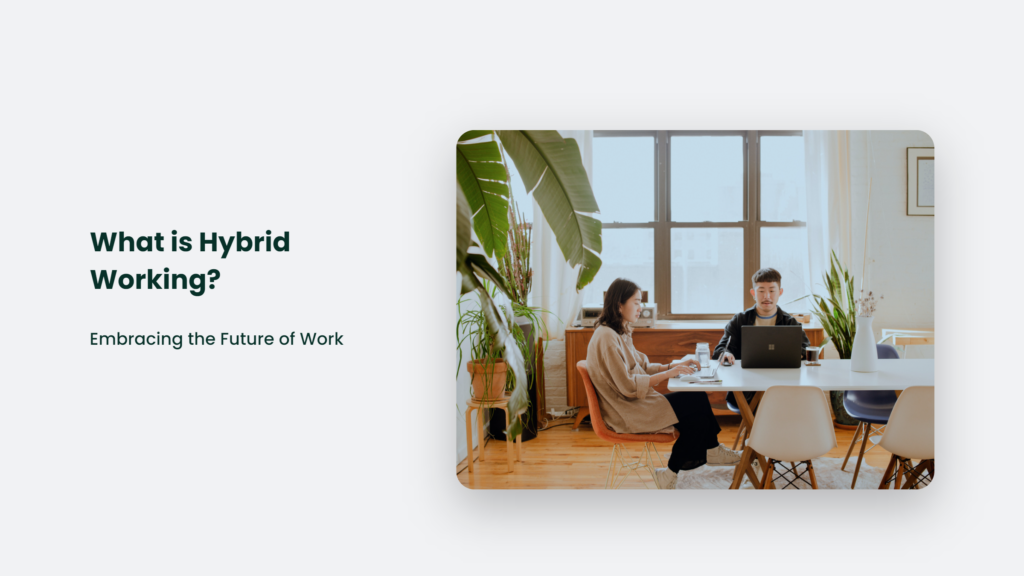

What is Hybrid Working? Embracing the Future of Work

As Seen On
Welcome to the ultimate guide on figuring out what is hybrid working, where we’ll dive headfirst into the world of flexible work arrangements and explore the future of work. But first, let’s address the elephant in the room: why should you give a damn about hybrid working? Well, my friend, it’s because hybrid working is revolutionizing how we approach our jobs, and it’s about time we all got on board with this game-changing trend.
In this comprehensive guide, we’ll dissect the ins and outs of hybrid working like a mad scientist in a lab, uncovering its benefits, challenges, and the secret sauce to successfully implementing it in your organization.
So, grab a cup of coffee, put on your thinking cap, and dive into the wild world of hybrid working. It’s time to embrace the future of work and give a big, fat middle finger to the traditional 9-to-5 grind. Are you ready? Let’s do this!

What is Hybrid Working?
Hybrid working is a flexible working model where employees work partly in the physical workplace and partly remotely, usually from their homes or other workspaces. This innovative approach to work has gained significant traction in recent years, particularly due to the COVID-19 pandemic, which forced many organizations to adapt to remote work.
As we move forward, hybrid working is becoming the new norm for many companies, offering a perfect balance between office life and remote work.
The Benefits of Hybrid Working: A Deeper Dive
Hybrid working offers numerous advantages for both employees and organizations. Let’s take a closer look at some of the key benefits:
Increased productivity and efficiency:
Hybrid working allows employees to work in environments where they feel most productive, leading to increased efficiency. For example, employees who prefer a quiet environment can work from home, while those who thrive in a collaborative setting can work in the office. This flexibility can lead to higher levels of job satisfaction and, ultimately, better performance.
Improved work-life balance:
By offering flexible work schedules, hybrid working helps employees maintain a healthy work-life balance. It can reduce stress levels, increase job satisfaction, and improve overall well-being. For instance, employees can save time on commuting and use that time for personal or family activities, contributing to a more balanced lifestyle.
Reduced operating costs:
Companies can save on office space and other overhead costs by adopting a hybrid work model. It can lead to significant cost savings, which can be reinvested in other business areas, such as employee development or technology upgrades.
Attracting and retaining talent:
Offering hybrid working options can make your organization more attractive to potential employees and help retain existing talent. A flexible work environment can be a deciding factor for job seekers, especially those who value work-life balance and autonomy.
Overcoming the Challenges of Hybrid Working: Strategies for Success
While hybrid working offers numerous benefits, it also presents some challenges. Here are some strategies to help your organization overcome these obstacles:
Communication and Coordination
One of the main challenges of hybrid working is maintaining effective communication and coordination among team members. Invest in communication tools and platforms that facilitate seamless collaboration to overcome this. Encourage regular check-ins and updates to keep everyone on the same page.
Additionally, consider implementing a centralized project management system to track tasks and deadlines, ensuring all team members know their responsibilities and progress.
Connection and Culture
Building a strong company culture and fostering employee connections can be challenging in a hybrid work environment. To address this, organize regular team-building activities, both in-person and virtual, to help employees bond and maintain a sense of belonging.
Encourage informal interactions, such as virtual coffee breaks or team lunches, to promote camaraderie and strengthen colleague relationships.
Creativity and Innovation
Hybrid working can sometimes hinder creativity and innovation, as spontaneous brainstorming sessions and face-to-face interactions are less frequent. To counter this, schedule regular brainstorming sessions and encourage employees to share their ideas and collaborate on projects, regardless of location. Implement tools and platforms that facilitate idea sharing and creative collaboration, such as virtual whiteboards or brainstorming apps.
Performance Management and Accountability
In a hybrid work environment, monitoring employee performance and ensuring accountability can be challenging. To address this, establish clear performance metrics and expectations for all employees, regardless of their work location. Implement regular performance reviews and feedback sessions to help employees stay on track and continuously improve.
Additionally, foster a culture of trust and autonomy, empowering employees to take ownership of their work and make decisions independently.
Implementing a Successful Hybrid Work Model: A Step-by-Step Guide:
Define your hybrid work model:
Determine the right balance between in-office and remote work for your organization. Consider factors such as the nature of your business, employee preferences, and the need for collaboration. Survey your employees to gather insights on their preferred work arrangements and use this information to inform your hybrid work model.
Establish clear policies and guidelines:
Develop clear policies and guidelines for hybrid working, including expectations for communication, availability, and performance. Ensure these policies are communicated effectively to all employees and provide resources to help them understand and adhere to the guidelines.
Invest in technology:
Equip your employees with the necessary tools and technology to work effectively in a hybrid environment. It may include collaboration platforms, video conferencing tools, project management systems, and secure remote access solutions.
Provide training and support:
Offer training and support to help employees adapt to the new work model and overcome challenges. It may include workshops on remote work best practices, time management, communication skills, and resources on mental health and well-being.
Monitor and adjust:
Continuously evaluate the effectiveness of your hybrid work model and make adjustments as needed to ensure its success. Collect employee feedback and use data-driven insights to identify areas for improvement and refine your approach.
Frequently Asked Questions:
What are some challenges of hybrid working?
Some challenges of hybrid working include maintaining effective communication and coordination, fostering connection and culture, and promoting creativity and innovation.
What are some examples of companies that have successfully implemented hybrid working models?
Some examples of companies that have successfully implemented hybrid working models include Microsoft, Google, Facebook, and Twitter.
What is the main purpose of hybrid working?
The main purpose of hybrid working is to provide employees with the flexibility to work in environments where they feel most productive and maintain a healthy work-life balance while allowing organizations to save on operating costs and attract top talent.
The Bottom Line:
In conclusion, hybrid working is the future of work, offering numerous benefits for employees and organizations. By understanding its challenges and implementing effective strategies, your organization can successfully embrace this new work model and thrive in the ever-evolving business landscape.
Gracie Jones
Up until working with Casey, we had only had poor to mediocre experiences outsourcing work to agencies. Casey & the team at CJ&CO are the exception to the rule.
Communication was beyond great, his understanding of our vision was phenomenal, and instead of needing babysitting like the other agencies we worked with, he was not only completely dependable but also gave us sound suggestions on how to get better results, at the risk of us not needing him for the initial job we requested (absolute gem).
This has truly been the first time we worked with someone outside of our business that quickly grasped our vision, and that I could completely forget about and would still deliver above expectations.
I honestly can’t wait to work in many more projects together!
Disclaimer
*The information this blog provides is for general informational purposes only and is not intended as financial or professional advice. The information may not reflect current developments and may be changed or updated without notice. Any opinions expressed on this blog are the author’s own and do not necessarily reflect the views of the author’s employer or any other organization. You should not act or rely on any information contained in this blog without first seeking the advice of a professional. No representation or warranty, express or implied, is made as to the accuracy or completeness of the information contained in this blog. The author and affiliated parties assume no liability for any errors or omissions.

